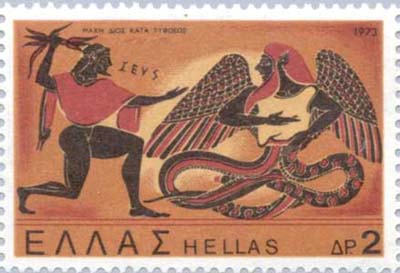
Typhon (Typhaon, Typhoeus, Typhus, (Τυφών / Τυφωεύς), in Greek mythology, was the final son of Gaia, this time with Tartarus, the offspring of the Earth and the cavernous void beneath:
But when Zeus had driven the Titans from heaven,
huge Earth bare her youngest child Typhoeus of the love of
Tartarus, by the aid of golden Aphrodite. —Hesiod, Theogony 820-868.
The Homeric Hymn to Apollo makes the monster Typhaon at Delphi a son of archaic Hera in her Minoan form, produced out of herself, like a monstrous version of Hephaestus, and whelped in a cave in Cilicia and confined there in the enigmatic land of the Arimi— en Arimois (Iliad, ii. 781-783). It was in Cilicia that Zeus battled with the ancient monster and overcame him, in a more complicated story: It was not an easy battle: Typhon temporarily overcame Zeus, cut the "sinews" from him and left him in the "leather sack," the korukos that is the etymological origin of the korukion atron, the Korykian or Corycian Cave. The region of Cilicia in southeastern Anatolia had many opportunities for connection with the Hittites to the north. Walter Burkert notes some close aggreements with the Hittite myth of Illuyankas.
The inveterate enemy of the Olympian gods is described as a vast grisly monster with a hundred heads and a hundred serpents issuing from his thighs, who was conquered and cast into Tartarus by Zeus. or confined beneath Mount Etna (Pindar, Pythian Ode 1.19 - 20; Aeschylus, Prometheus Bound 370) where "his bed scratches and goads the whole length of his back stretched out against it," or in other volcanic regions, where he is the cause of eruptions.
Typhon is thus the chthonic figuration of volcanic forces, as Hephaestus (Roman Vulcan) is their Olympian manifestation. Amongst his children by Echidna are Cerberus, the serpent-like Lernaean hydra, and the Chimaera.
Typhon is also the father of hot dangerous winds (Greek "typhein" to smoke), which were extended by the Persians ( طوفان Tufân) and Arabs to include the cyclonic storms of the Indian Ocean, hence English typhoon. Furthermore, there is a resemblance in pronunciations between the word Typhon and the Chinese phrase "tái fēng" (颱風, "typhoon"), which probably originated from the phrase "fēng shāi" (風篩, "sieve-like wind") in the Chinese dialect of Min. It is still unknown whether there is a linguistic connection between the two phrases.
Later Hellenistic writers identified Typhon with the Egyptian Set, and religious scholars identify him with the Archangel Sandalphon.
Images
The monster Typhon, Laconian cylix, 560 - 555 BC.
References
Greek Religion, Walter Burkert
The Greek Myths: The Complete And Definitive Edition, Robert Graves
Gods of the Greeks, Carl Kerenyi
See also : Greek Mythology. Paintings, Drawings
Greek Mythology Index
A - B - C - D - E - F - G - H - I - J - K - L - M -
N - O - P - Q - R - S - T - U - V - W - X - Y - Z
Α - Β - Γ - Δ - Ε - Ζ - Η - Θ - Ι - Κ - Λ - Μ -
Ν - Ξ - Ο - Π - Ρ - Σ - Τ - Υ - Φ - Χ - Ψ - Ω
Retrieved from "http://en.wikipedia.org/"
All text is available under the terms of the GNU Free Documentation License
| Ancient Greece
Science, Technology , Medicine , Warfare, , Biographies , Life , Cities/Places/Maps , Arts , Literature , Philosophy ,Olympics, Mythology , History , Images Medieval Greece / Byzantine Empire Science, Technology, Arts, , Warfare , Literature, Biographies, Icons, History Modern Greece Cities, Islands, Regions, Fauna/Flora ,Biographies , History , Warfare, Science/Technology, Literature, Music , Arts , Film/Actors , Sport , Fashion --- |

